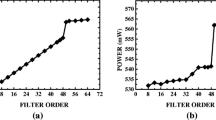Abstract
This paper presents a study of the suitability for FPGA design of full custom based CORDIC implementations. Since all these methods are based on redundant arithmetic, the FPGA implementation of the required operators to perform the different CORDIC methods has been evaluated. Efficient mappings on FPGA have been performed leading to the fastest implementations. It is concluded that the redundant arithmetic operators require a 4 to 5 times larger area than the conventional architecture and the speed advantages of the full custom design has been lost. That is due to the longer routing delays caused by the increase of the fan-out and the number of nets. Therefore, the redundant arithmetic based CORDIC methods are not suitable for FPGA implementation, and the conventional two's complement architecture leads to the best performance.
Similar content being viewed by others
References
P.J. Graumann and L.E. Turner, “Implementing Digital Signal Processing Algorithms Using Pipelined Bit-Serial Arithmetic and Field Programmable Gate Arrays,” in First International ACM/SIGDA Workshop on Field Programmable Gate Arrays (FPGA'92), 1992.
J. Isoaho, J. Pasanen, O. Vainio, and H. Tenhunen, “DSP System Integration and Prototyping with FPGAs,” Journal of VLSI Signal Processing, vol. 6, 1993, pp. 155-172.
M. Wahab and D. Puckey, “FPGA-Based DSP Systems,” in Abindon EE&CS books, W.R. Moore and W. Luk (Eds.), 1994.
R.J. Petersen and B. Hutchings, “An Assessment of the Suitability of FPGA-Based Systems for Use in DSPs,” in Lecture Notes in Computer Science, Springer-Verlag, Berlin, 1995, no. 975, pp. 293-302.
J.E. Volder, “The CORDIC Trigonometric Computing Technique,” IRE Trans. Electronic Computers, vol. EC-8,no. 3, 1959, pp. 330-334.
J.S. Walther, “A Unified Algorithm for Elementary Functions,” in Proc. Spring. Joint Comput. Conference, vol. 38, 1971, pp. 379-385.
Y. Hu, “CORDIC-Based VLSI Architectures for Digital Signal Processing,” IEEE Signal Processing Magazine, vol. 9,no. 3, July 1992, pp. 16-35.
R. Andraka, “A Survey of CORDIC Algorithms for FPGAs,” in Proceedings of the 1998 ACM/SIGDA Sixth International Symposium on Field Programmable Gate Arrays (FPGA '98), Monterey, CA, Feb. 22–24, 1998, pp. 191-200.
U. Meyer-Base, A. Meyer-Base, and W. Hilberg, “COordinate Rotation DIgital Computer (CORDIC) Synthesis for FPGA,” in 4th International Workshop on Field Programmable Logic and Applications (FPL'94), Prag, Czech Republic, 7–9 September, 1994.
C. Dick, “Computing the Discrete Fourier Transform on FPGA Based Systolic Arrays,” in ACM/SIGDA Int. Symp. on Field Programmable Gate Array, Feb. 1996, pp. 129-135.
U. Meyer-Base, A. Meyer-Base, J. Mellott, and F. Taylor, “A Fast Modified CORDIC-Implementation of Radial Basis Neural Networks,” Journal of VLSI Signal Processing, vol. 20, 1998, pp. 211-218.
M.A. Mayosky, P.E. Battaiotto, and G.M. Toccaceli, “A CORDIC Architecture for Vector Control,” in Proc. of the Int. Conf. on Signal Processing Applications and Technology, 1998.
N. Takagi, T. Asada, and S. Yajima, “Redundant CORDIC Methods with a Constant Scale Factor for Sine and Cosine Computation,” IEEE Transactions on Computers, vol. 40,no. 9, 1991.
J.-A. Lee and T. Lang, “Constant-Factor Redundant CORDIC for Angle Calculation and Rotation,” IEEE Transactions on Computers, vol. 41,no. 8, 1992.
H. Lin and A. Sips, “On-Line CORDIC Algorithms,” IEEE Transactions on Computers, vol. 39, 1990, pp. 1038-1052.
J. Duprat and J.-M. Muller, “The CORDIC Algorithm: New Results for Fast VLSI Implementation,” IEEE Transactions on Computers, vol. 42, 1993, pp. 168-178.
H. Dawid and H. Meyr, “The Differential CORDIC Algorithm: Constant Scale Factor Redundant Implementation without Correcting Iterations,” IEEE Transactions on Computers, vol. 45,no. 3, 1996.
S. Wang, V. Piuri, and E. Swartzlander, “Hybrid CORDIC Algorithms,” IEEE Transactions on Computers, vol. 46, 1997, pp. 1202-1207.
C. Li and S. Chen, “A Radix-4 Redundant CORDIC Algorithm with Fast On-Line Variable Scale Factor Compensation,” in Int. Symposium of Circuit and Systems (ISCAS'97), Hong Kong, Jun. 1997, pp. 639-642.
R.R. Osorio, E. Antelo, J. Bruguera, and E. Zapata, “Digit On-Line Large Radix CORDIC Rotator,” in Int. Conf. On Application-Specific Array Processors, Strasbourg, France, Jul. 1995, pp. 247-257.
J. Villalba, J. Hidalgo, E. Zapata, E. Antelo, and J. Bruguera, “CORDIC Architectures with Parallel Compensation of the Scale Factor,” in Int. Conf. on Application-Specific Array Processors, Strabourg, France, Jul. 1995, pp. 258-269.
Shen-Fu Hsiao and Jean-Marc Delosme, “Householder CORDIC Algorithm,” IEEE Transactions on Computers, vol. 44,no. 8, 1995.
Shen-Fu Hsiao and Jen-Yin Chen, “Design, Implementation and Analysis of a New Redundant CORDIC Processor with Constant Scaling Factor and Regular Structure,” Journal of VLSI Signal Processing, vo. 20, 1998, pp. 267-278.
Shen-Fu, Hsiao, “A High-Speed Constant-Factor Redundant CORDIC Processor without Extra Correcting or Scaling Iterations,” in IEEE Int. Conf. On Circuits and Systems (ISCAS'99), Florida, 1999.
M. Kuhlmann and K.K. Parhi, “A High-Speed CORDIC Algorithm and Architecture for DPS Applications,” in Proc. of the 1999 IEEE Workshop on Signal Processing Systems (SiPS'99), Taipei, Taiwan, Oct. 1999.
M. Kuhlmann and K.K. Parhi, “A New CORDIC Rotation Method for Generalized Coodinate Systems,” in Proc. of the 1999 Asilomar Conference on Signal, Systems and Computers, Pacific Grove, CA, Oct. 1999.
J. Moran, I. Rios, and J. Meneses, “Signed Digit Arithmetic on FPGAs,” in More FPGAs, pp. 251-261, W.R. Moore and W. Luk (Eds.), Abindon EE&CS books, 1994.
K.K. Parhi, VLSI Digital Signal Processing Systems: Design and Implementation, Wiley and Sons, 1999.
M.D. Ercegovac and T. Lang, “On-the-Fly Conversion of Redundant into Conventional Representations,” IEEE Transactions on Computers, vol. 36, 1987, pp. 895-897.
D. Timmermann and S. Dolling, “Unfolded Redundant CORDIC VLSI Architectures with Reduced Area and Power Consumption,” in Int. Conf. on VLSI 97, Brasilia, Sept. 1997.
A. Wassatsch, S. Dolling, and D. Timmermann, “Area Minimization of Redundant CORDIC Pipeline Architectures,” in IEEE International Conference on Computer Design (ICCD '98), Austin, Texas, October 1998.
Author information
Authors and Affiliations
Rights and permissions
About this article
Cite this article
Valls, J., Kuhlmann, M. & Parhi, K.K. Evaluation of CORDIC Algorithms for FPGA Design. The Journal of VLSI Signal Processing-Systems for Signal, Image, and Video Technology 32, 207–222 (2002). https://doi.org/10.1023/A:1020205217934
Published:
Issue Date:
DOI: https://doi.org/10.1023/A:1020205217934




